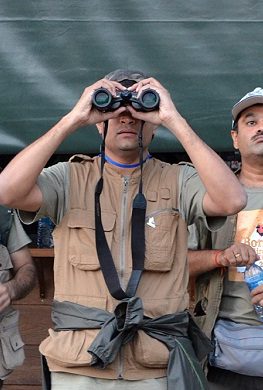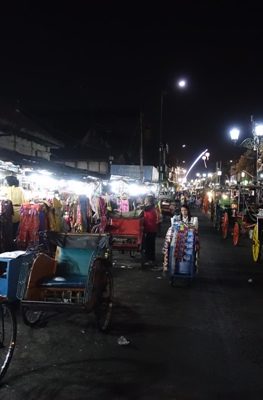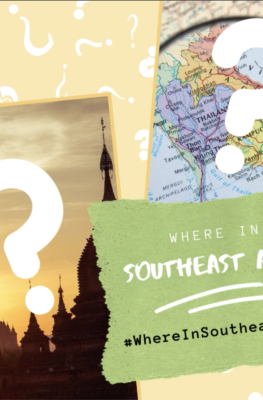Published on September 22, 2017
Ric Gazarian standing next to a tuk-tuk. Image courtesy of Ric Gazarian.
Spend a few jaw-clenching winters in Chicago in the U.S., and you’d be taking the first flight to Bangkok, too. That’s what Ric Gazarian did: “I had a couple of friends in Chicago who were spending the winters in Miami,” he told me. “I said to myself, why are my friends so smart and why am I so dumb? I shouldn’t be here!”
Volunteer work was Ric’s second reason for making the move: “I read a book called the Gospel of Father Joe,” he confided. “It’s is the real story of an American priest who moved to Bangkok in the 1970s and started doing all these great works on behalf of the Thai people. I read the book and said, ‘I’m going to go and volunteer for Father Joe.’”
After five years working, volunteering and traveling through Thailand, Ric’s set up a pretty sweet life in Southeast Asia, with a business that gives him plenty of time to travel – giving him material for his successful travel blog and podcast. We interviewed Ric about how he manages to make long-term travel in Southeast Asia look easy; he had a lot to share.
Q: Tell us about your work in travel, Ric.
RIC: I’ve been blogging coming up on three years on my blog Global Gaz, where I share my experiences as I attempt to travel to every country in the world. There’s 193 countries, currently I’m at 110.
On top of that I have a podcast on Itunes and Stitcher and all that good stuff, called Counting Countries – I interview people who’ve been to every country in the world, some truly fascinating people who have done what very few people have done.
I’m also the chapter leader of Travel Massive Bangkok; it’s a professional network for travel industry people, and I also run a meetup in Bangkok called the Bangkok International Travel Group with 2,500 members based in Thailand. That’s simply people who love to travel, and I host meetups on a monthly basis in Bangkok, bringing guest speakers.
Bangkok at night. Image courtesy of the Tourism Authority of Thailand.
Q: So give us the short version of how you made the long trip from Chicago in the U.S. to Bangkok.
RIC: I [had a] job in the financial sector, but after I got laid off I took an 11-month trip around the world. When I was on that trip, I decided that I didn’t want to go back to the corporate life, I wanted to make travel more of my life.
I started a business that now supports me. The business is based in Chicago, it’s real estate investing. But I set it up in such a way where as long as I have Internet I can manage this business wherever I am. One, it gives me the income to live, and two, it gives me the flexibility to travel.
Now I spend about six months a year in Bangkok; two months in the US, give or take; then the remainder traveling somewhere in the world. Might be SEAsia, might be in Africa, just three to four months just randomly traveling around.
Q: Why Bangkok as a base for long term travel?
RIC: It’s centrally located in Southeast Asia; there’s two great airports where tons of discount airlines are connecting through or making their hubs; flexibility and the ability to basically travel anywhere in Southeast Asia on a direct basis.
Thailand itself is an incredible country as well. We have Bangkok – a true melting pot of a megacity with 10 million plus people – you have the mountains up north in Chiang Mai and Chiang Rai, and of course in the South, you have incredible islands of opportunity. There’s Isaan in the east; Kanchanaburi in the west. It’s an extremely diverse country that packs in so much from ancient history to amazing food to beautiful beaches to ethnic tribes to a global city and everything in between.
Rai Le Beach in Krabi, Image courtesy of the Tourism Authority of Thailand.
Strawberry Field at Ang Khang Royal Agricultural Station , Chiang Mai, Image courtesy of the Tourism Authority of Thailand.
It’s a great mix of Western and Eastern. If you’re living in Bangkok, you can live like a local, shop like a local, hang out with locals, eat like a local – or if you don’t want to do that, you can go shopping with the latest brands in beautiful shopping malls, and you can eat Peruvian fusion food with a real Peruvian chef!
And it’s probably not the cheapest country in Southeast Asia, but compared to the West, your dollar goes significantly further in Thailand than it does back home.
For Southeast Asia itineraries that cover Bangkok along the way, book this 8-day, 7-night visit to Southeast Asia’s key exponents of high culture, this 9-day/8-night excursion through Thailand and two other countries, and this massive 29-day, 28-night tour of nine Southeast Asia countries.
Novice studying in Mrauk U, Myanmar. Image courtesy of Myanmar Tourism.
Q: As a traveler, which countries do you feel travelers should visit first, after setting up a base in Southeast Asia?
RIC: I personally think the Southeast Asia region is arguably one of the best areas in the world to travel for just incredible experiences, things to see, things to do.
I love all the countries [in ASEAN], I’ve been to all of them. One of my favorites, I think, is Myanmar, I went for my third time this March. You can go there overland, but take a 60-90 minute flight – you can get it for as cheap as 50 dollars direct from Bangkok.
It’s probably a generation behind in development compared to Thailand, but there is so much to see there, so much to do, with incredibly friendly people. It’s a big diverse, interesting country.
[In Myanmar], Bagan is potentially my favorite place, visually, in Southeast Asia. This year I visited Mrauk U. There’s a whole series of temples in Mrauk U; my understanding it’s the second biggest collection of temples in Myanmar, after Bagan. Totally different feel, much more isolated.
There’s no flights to Mrauk U, you gotta fly to Sittwe and take a four-hour boat ride to get there. Mrauk U, for all intents and purposes, is empty of tourists compared to Bagan, the temples are pretty fantastic there as well, and it’s hilly compared to the flatness of Bagan, just another fascinating and interesting place to visit in the country.
For Southeast Asia itineraries that include the majestic temple plain of Bagan in Myanmar, embark on this 8-day, 7-night trip between Myanmar and Thailand‘s top destinations, or go on this epic 18-day, 17-night expedition from Myanmar to the Malay Peninsula
Working in a Bangkok hostel balcony. Image © neajjean/Creative Commons
Q: For anyone planning to stay long-term in Southeast Asia, how can they earn a living here?
RIC: They can find one based upon whatever business they’re doing. There’s a great group of digital nomads in Chiang Mai, as well as in Bangkok. [There they have] great communities, great support, good resources, good internet, good coworking spaces, so it’s arguably a place you should consider working if you’re going to be a digital nomad.
Teaching is another great opportunity for people. In general, I will say if you’re competent, and you fly to Thailand, probably within a month or two, you’re going to have a teaching job.
My two cents, is you should time your visit a month or two before the school year begins, because that’s when people start looking to hire teachers. It’s probably not as smart to show up in the middle of the school year!
Start joining teacher networking groups, and start networking – meet up with friends of friends of friends who are teaching there, start talking to a lot of people. I think it’s 100% doable to pick up a teaching gig and get the work permit visa working in a school in Thailand.
I know a lot of foreigners working in the tourism industry in Bangkok, but I would say, for tourism jobs you’d have to do a lot more networking and work to be able to get one of those jobs. It’s a hundred percent doable.
Imitating the Thai Ronald McDonalds’ wai. Image © Connie/Creative Commons
Q: What’s the secret to successfully settling in to a long-term stay in Thailand?
RIC: If your’e going to go over to Thailand, make your experience more worthwhile in terms of building good relationships. One website that was helpful to me was Meetup.com. Meetup has dozens or hundreds of clubs; so if you like football, you like reading books, or badminton, or travel, etc., you can click, join up those clubs and meet people. So it’s a great way to network and meet people who share the same attraction to activities and hobbies that you like.
Join other Facebook groups like Desperately Seeking Bangkok, or other groups like Thailand Expat Hub – again, network with people, get great experiences.
Q: Speaking as someone who spends a good amount of time volunteering in Southeast Asia, what do you suppose long-term travelers could do better when it comes to finding charitable causes to volunteer for?
RIC: I think one of the issues that’s coming up is the ethical treatment of animals, elephants. There’s rules now in terms of how to interact with elephants, there’s a major push of not riding elephants, not physically interacting with them.
There’s also the challenges of orphanages, where I’ve heard stories where the children might not necessarily be orphans, but they’re given away by families and then housed in an orphanage setting to attract foreigners and tourists to donate money and time.
Like anything, do your research, start networking, do your best to make sure you’re working for a responsible, ethical organization.
I’ll give a shout out to where I volunteer right now; which is Mercy Centre in Bangkok.






